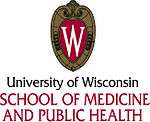University of Wisconsin School of Medicine and Public Health
 | |
| Type | Public |
|---|---|
| Established | 1907 |
| Dean | Robert N. Golden, MD |
Administrative staff | 1345 |
| Students | 614 (MD), 2114 (TOTAL) |
| Location | Madison, Wisconsin, USA |
| Campus | Urban |
| Website |
med |
 | |
The University of Wisconsin School of Medicine and Public Health (UWSMPH) is a professional school for the study of medicine and public health at the University of Wisconsin–Madison. It is one of only two medical schools in Wisconsin, along with the Medical College of Wisconsin in Milwaukee, and the only public one.
History
The medical school was proposed in 1848 and a two-year basic science course began in 1907. Charles R. Bardeen was the first dean of the medical school. The first four-year class matriculated in 1925, and the entire UWSMPH moved into the state-of-the-art Health Sciences Learning Center in 2004 .
Rankings
The UWSMPH has been ranked by U.S. News and World Report as one of the nation's best primary-care medical schools and among the top 30 research schools. In the 2014 edition of graduate school rankings, UWSMPH was listed as 9th in primary-care education and as 28th among research schools.[1] The UW School of Medicine and Public Health also ranks as one of the top medical schools in terms of research funding and expenditures, allocating US$446 million to research expenditures in 2006.[2]
The UWSMPH is an academic center for embryonic stem cell research, with UWSMPH Professor of Anatomy James Thomson being the first scientist to isolate human embryonic stem cells. This has brought significant attention to the University's research programs. Stem cell research at the school is aided in part by funding from the Wisconsin Alumni Research Foundation and the promotion of WiCell.
The school also has teaching and research partnerships with the University of Wisconsin Hospital and Clinics and the University of Wisconsin Medical Foundation, one of the 10 largest physician practice groups in the country.[3] Although students are trained to work in a range of patient care and research areas and the school is committed to training physicians for rural health care, the UWSMPH has chosen seven core areas of medicine on which it focuses its resources: Aging, Cancer, Cardiovascular and Respiratory Sciences, Neuroscience, Population and Community Health Sciences, Rural Health, and Women's Health.[4]
Admissions to UWSMPH is competitive, with 7.6% of applicants accepted in 2007. The acceptance rate for out-of-state applicants is significantly lower; of 2,674 out-of-state applicants in 2007, 167 were interviewed for 34 spots, an acceptance rate of 3.7%; the in-state rate was 23.2%. The matriculates had an average GPA of 3.76 and an MCAT score of 32.[5]
Programs
UWSMPH has a Medical Scientist Training Program, or MD/PhD program that is funded by the NIH. There is also the Wisconsin Academy for Rural Medicine (WARM) for students intending to practice in rural areas as well as the Training in Urban Medicine and Public Health (TRIUMPH) program for students interested in practicing in urban areas.[6][7]
Notable alumni
Notable alumni of the school include:
- Howard Engle (1919–2009), physician and lead plaintiff in a landmark lawsuit against the tobacco industry[8]
See also
References
- ↑ "Best Graduate Schools". U.S. News and World Report. U.S. News and World Report, L.P. Retrieved 2014-07-12.
- ↑ "Facts". Retrieved 2009-06-11.
- ↑ "About the UW School of Medicine and Public Health". Retrieved 2009-06-11.
- ↑ "About the UW School of Medicine and Public Health". Retrieved 2009-06-11.
- ↑ "UWSMPH from Premium Online Edition of US News and World Report".
- ↑ "Training in Urban Medicine and Public Health (TRIUMPH)". University of Wisconsin School of Medicine and Public Health. Retrieved 7 December 2012.
- ↑ "Wisconsin Academy for Rural Medicine (WARM)". University of Wisconsin School of Medicine and Public Health. Retrieved 7 December 2012.
- ↑ Weber, Bruce. "H. A. Engle, Tobacco Plaintiff, Dies at 89", The New York Times, July 24, 2009. Accessed July 25, 2009.